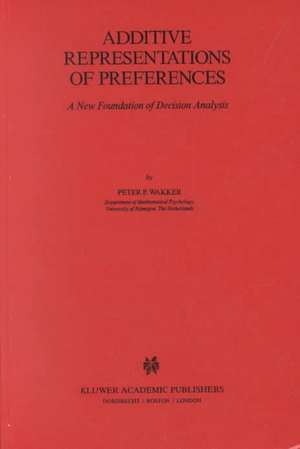Additive Representations of Preferences: A New Foundation of Decision Analysis: Theory and Decision Library C, cartea 4
Autor P. P. Wakkeren Limba Engleză Hardback – 31 dec 1988
| Toate formatele și edițiile | Preț | Express |
|---|---|---|
| Paperback (1) | 636.12 lei 6-8 săpt. | |
| SPRINGER NETHERLANDS – 8 dec 2010 | 636.12 lei 6-8 săpt. | |
| Hardback (1) | 642.51 lei 6-8 săpt. | |
| SPRINGER NETHERLANDS – 31 dec 1988 | 642.51 lei 6-8 săpt. |
Din seria Theory and Decision Library C
-
 Preț: 388.13 lei
Preț: 388.13 lei - 15%
 Preț: 642.51 lei
Preț: 642.51 lei - 18%
 Preț: 952.40 lei
Preț: 952.40 lei - 15%
 Preț: 648.24 lei
Preț: 648.24 lei - 18%
 Preț: 1227.36 lei
Preț: 1227.36 lei - 15%
 Preț: 643.00 lei
Preț: 643.00 lei - 15%
 Preț: 641.53 lei
Preț: 641.53 lei - 15%
 Preț: 640.88 lei
Preț: 640.88 lei - 15%
 Preț: 645.60 lei
Preț: 645.60 lei - 18%
 Preț: 951.77 lei
Preț: 951.77 lei - 15%
 Preț: 644.82 lei
Preț: 644.82 lei - 18%
 Preț: 952.89 lei
Preț: 952.89 lei - 18%
 Preț: 1391.52 lei
Preț: 1391.52 lei - 18%
 Preț: 953.82 lei
Preț: 953.82 lei - 18%
 Preț: 1220.39 lei
Preț: 1220.39 lei -
 Preț: 395.25 lei
Preț: 395.25 lei - 15%
 Preț: 639.73 lei
Preț: 639.73 lei - 18%
 Preț: 1840.11 lei
Preț: 1840.11 lei - 18%
 Preț: 946.72 lei
Preț: 946.72 lei - 18%
 Preț: 1222.17 lei
Preț: 1222.17 lei - 15%
 Preț: 645.60 lei
Preț: 645.60 lei - 15%
 Preț: 638.11 lei
Preț: 638.11 lei - 15%
 Preț: 645.47 lei
Preț: 645.47 lei - 15%
 Preț: 646.94 lei
Preț: 646.94 lei - 18%
 Preț: 952.72 lei
Preț: 952.72 lei - 18%
 Preț: 952.89 lei
Preț: 952.89 lei
Preț: 642.51 lei
Preț vechi: 755.88 lei
-15% Nou
Puncte Express: 964
Preț estimativ în valută:
122.94€ • 128.71$ • 101.73£
122.94€ • 128.71$ • 101.73£
Carte tipărită la comandă
Livrare economică 05-19 aprilie
Preluare comenzi: 021 569.72.76
Specificații
ISBN-13: 9780792300502
ISBN-10: 0792300505
Pagini: 210
Ilustrații: X, 196 p.
Dimensiuni: 156 x 234 x 17 mm
Greutate: 0.48 kg
Ediția:1988
Editura: SPRINGER NETHERLANDS
Colecția Springer
Seria Theory and Decision Library C
Locul publicării:Dordrecht, Netherlands
ISBN-10: 0792300505
Pagini: 210
Ilustrații: X, 196 p.
Dimensiuni: 156 x 234 x 17 mm
Greutate: 0.48 kg
Ediția:1988
Editura: SPRINGER NETHERLANDS
Colecția Springer
Seria Theory and Decision Library C
Locul publicării:Dordrecht, Netherlands
Public țintă
ResearchCuprins
0. Elementary Definitions.- I. From Choice Functions to Binary Relations.- II. Cartesian Product Structure.- III. Additive Representations.- IV. Continuous Subjective Expected Utility.- V. Continuous Subjective Expected Utility for Arbitrary State Spaces.- VI. Subjective Expected Utility with Nonadditive Probabilities.- VII. Concavity on Mixture Spaces and Risk Aversion.- A1. Generalizations of midpoint convexity.- A2. Classical representations of seu-maximization.- A3. Further remarks.- Reference-Footnotes.- Reference-footnotes to Chapter I.- Reference-footnotes to Chapter II.- Reference-footnotes to Chapter III.- Reference-footnotes to Chapter IV.- Reference-footnotes to Chapter V.- Reference-footnotes to Chapter VI.- Reference-footnotes to Chapter VII.- Reference-footnotes to the Appendix.- References.- Author Index.- Notation Index.
Recenzii
`This book represents a very real and important contribution to the mathematics of decision theory.
The distinguishing feature of Wakker's approach is that he has no need of a reference experiment.
There are further results aplenty and much for the decision theorist to ponder. These results will also help psychologists, economists and others formulate and test models of decision-making behaviour.
By any standards its publication is a landmark ... excellent survey and summary of the literature on additive preference models. Each page represents the distillation of much thought. As a consequence, it is a book that rewards reading and rereading. Wakker's results and methods of proof will enlighten research into decision theory for many years.'
British Journal of Mathematical and Statistical Psychology, 43, 1990
The distinguishing feature of Wakker's approach is that he has no need of a reference experiment.
There are further results aplenty and much for the decision theorist to ponder. These results will also help psychologists, economists and others formulate and test models of decision-making behaviour.
By any standards its publication is a landmark ... excellent survey and summary of the literature on additive preference models. Each page represents the distillation of much thought. As a consequence, it is a book that rewards reading and rereading. Wakker's results and methods of proof will enlighten research into decision theory for many years.'
British Journal of Mathematical and Statistical Psychology, 43, 1990








